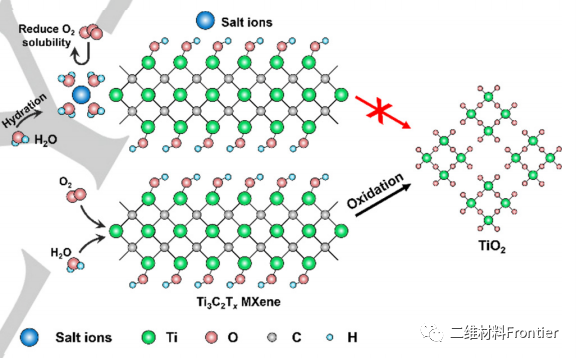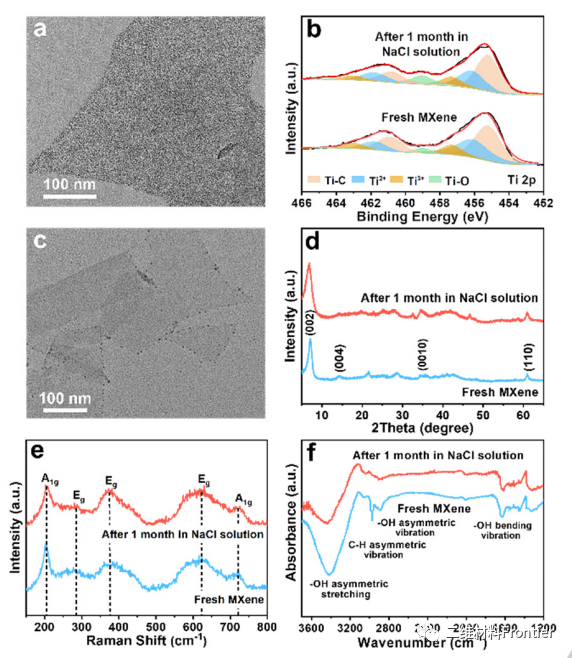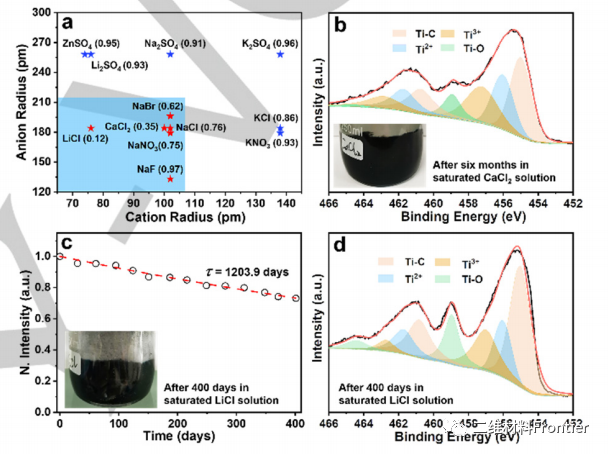Angewandte Chemie: Study on the hydration chemistry of stable MXene aqueous solutions

1. Article overview
MXene has attracted great interest in different fields, but suffers from rapid structural degradation due to attacking dissolved oxygen and water molecules in aqueous solutions. This shortcoming fundamentally hinders the long-term storage, application and understanding of the chemical properties of MXene. In this article, the author reports a cost-effective and environmentally sustainable non-toxic inorganic salting chemical method for long-term storage of manganese. By reducing water activity, it effectively inhibits the attack of free water and dissolved oxygen molecules, and at the same time reduces the activity of dissolved oxygen. Therefore, the storage life of MXene under environmental conditions can be significantly extended to 400 days without loss of internal surface chemistry and bulk carrier properties. More than 90% of the salt protectant can be recovered after the MXene is completely extracted by simply evaporating the final waste liquid to reduce waste discharge and treatment costs. This work provides an immediate commercial method for extending the shelf life of MXenes that is cost-effective, sustainable in processing, and environmentally beneficial.
2. Graphic guide

Figure 1. Schematic diagram of the protection mechanism of MXene by hydration chemistry.

Figure 2. (a) TEM image of MXene; (b) XPS spectra of MXene and MXene stored in saturated sodium chloride solution for one month. (c) TEM image of MXene protected by nacl. (d) XRD, (e) Raman and (f) FT-IR spectra of fresh and nacl protected MXene.

Figure 3. (a) Optical photograph and b) XRD patterns of Ti3C2TxMXene stored in sodium chloride solutions of different concentrations for 1 month. (c) The normalized UV-relative peak intensity of Ti3C2TxMXene stored in different concentrations of λ=785nm sodium chloride solution for different time. (d) Correlation between dissolved oxygen concentration or water activity and sodium chloride concentration in Ti3C2TxMXene or (e) Ti-O ratio. (f) The time scale (τ) relationship of Ti3C2TxMXene against dissolved oxygen synergistic oxidation or water activity in different concentrations of sodium chloride solution.

Figure 4. Characterization of Ti3c2Tz/PS armor particles: (a, b) SEM images, (c) XPS measurement spectrum and (d) XPS high resolution spectrum.
3. Full text summary
In summary, a method for long-term storage of hydration chemistry that can be commercialized immediately. The hydration of inorganic salts can significantly reduce the activity and coordination of dissolved oxygen in the aqueous solution to water. Therefore, the attack of free water and oxygen molecules on MXene can be suppressed to a large extent, which can be extended to 400 days, and the loss of surface chemistry and carrier properties can be neglected. MXene can be easily washed off to restore good dispersion and inherent properties of use. This strategy avoids the use of expensive and toxic reagents and tedious separation. The salt protectant can be recycled in large quantities through the evaporation of waste liquid to maximize cost-effectiveness and sustainability of processing.
Article link:
https://doi.org/10.1002/anie.202113981
This information is sourced from the Internet for academic exchanges only. If there is any infringement, please contact us to delete it immediately.
18915694570
Previous: Southwest Jiaotong Uni


